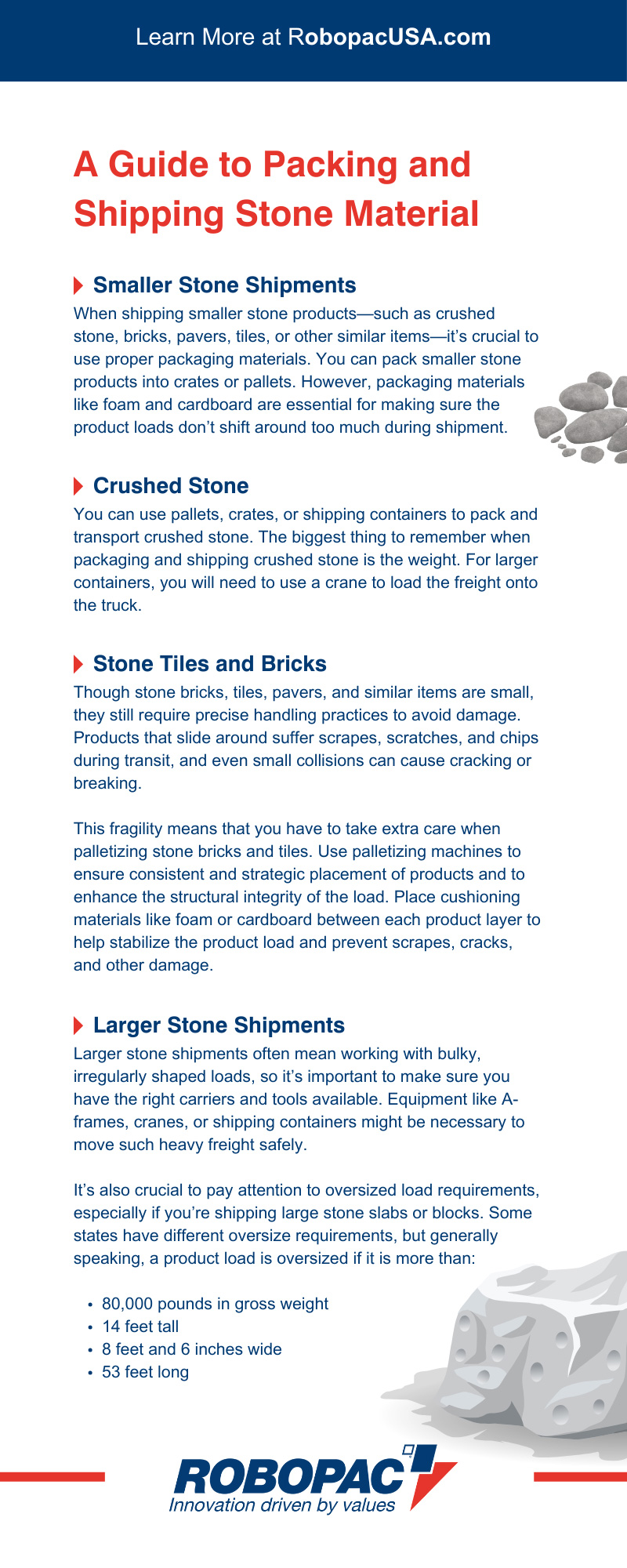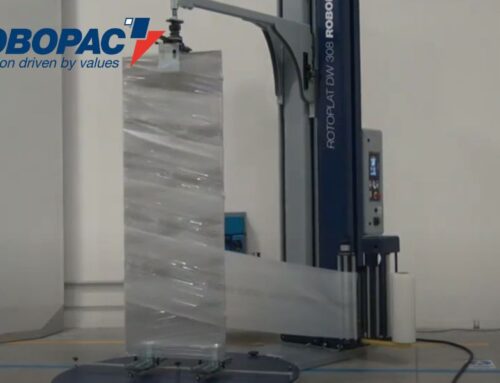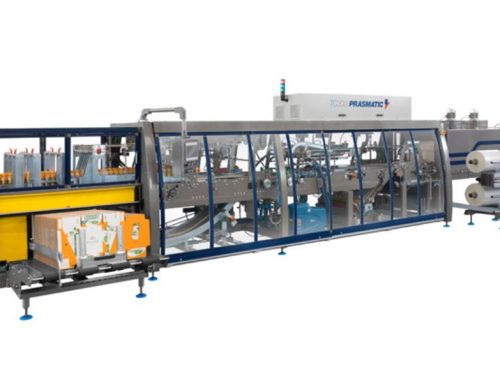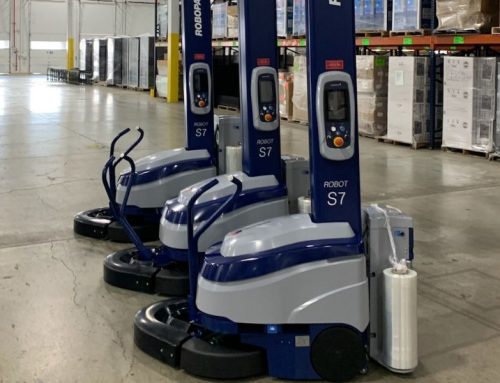From serving as sidewalks to decorating homes, stone products have a versatile role across a vast range of industries. This versatility lends itself to countless product types, including bricks, slabs, crushed rock, statues, tiles, and so much more.
These product types can create unique challenges in your supply chain due to their weight, size, or irregular shape. Figuring out how to safely package and ship different types of stone without damaging the products or wasting money and resources is key to delivering these goods safely and reliably to end users. Protect your products and find success in your supply chain with this guide to packing and shipping stone materials.
Smaller Stone Shipments
When shipping smaller stone products—such as crushed stone, bricks, pavers, tiles, or other similar items—it’s crucial to use proper packaging materials. You can pack smaller stone products into crates or pallets. However, packaging materials like foam and cardboard are essential for making sure the product loads don’t shift around too much during shipment. When packing cases or crates, make sure you use the right size container to avoid excess space. This will also help limit the movement of the stone, preventing it from shifting, scraping, or crashing against the sides of the container.
Additionally, it’s important to keep in mind that stone product loads are heavier than average loads, which means you might need specific equipment like loading docks or lift gates to load the freight into carrier trucks. Make sure you work with a carrier who can handle the unique needs of your stone product loads without too much extra cost or hassle.
Crushed Stone
You can use pallets, crates, or shipping containers to pack and transport crushed stone. The biggest thing to remember when packaging and shipping crushed stone is the weight. For larger containers, you will need to use a crane to load the freight onto the truck.
Because crushed stone usually consists of either a fine powder or rough chunks of stone, there is less concern about the shipments shifting and colliding during transit. However, when transporting loose stone in crates or shipping containers, you must be wary of open containers. Uncovered or unsecured containers can lead to loose rocks flying out of the shipment during transit. Even losing a stone or two can cause major accidents on the road, so take extra care to ensure all loose rock is covered and secure.
Stone Tiles and Bricks
Though stone bricks, tiles, pavers, and similar items are small, they still require precise handling practices to avoid damage. Products that slide around suffer scrapes, scratches, and chips during transit, and even small collisions can cause cracking or breaking.
This fragility means that you have to take extra care when palletizing stone bricks and tiles. Use palletizing machines to ensure consistent and strategic placement of products and to enhance the structural integrity of the load. Place cushioning materials like foam or cardboard between each product layer to help stabilize the product load and prevent scrapes, cracks, and other damage.
Avoid using less-than-truckload shipping to transport pallets of tiles and bricks. With LTL shipping, the risk of cargo sliding around and colliding with other freight increases, putting both you and others at risk of product loss.
Larger Stone Shipments
Larger stone shipments often mean working with bulky, irregularly shaped loads, so it’s important to make sure you have the right carriers and tools available. Equipment like A-frames, cranes, or shipping containers might be necessary to move such heavy freight safely.
It’s also crucial to pay attention to oversized load requirements, especially if you’re shipping large stone slabs or blocks. Some states have different oversize requirements, but generally speaking, a product load is oversized if it is more than:
- 80,000 pounds in gross weight
- 14 feet tall
- 8 feet and 6 inches wide
- 53 feet long
If you’re working with oversized loads, you need to partner with carriers who have oversize or overweight permits through the Department of Transportation or specific state departments. You will also need unique safety equipment like oversized banners and lighting gear. Pay attention to state and national requirements every time you ship an oversized load to ensure you stay compliant and avoid violation fees.
Stone Slabs
Like bricks and tiles, stone slabs are incredibly fragile, which means they’re susceptible to cracking or breaking if you don’t handle them correctly. Shipping slabs horizontally makes it very easy for them to crack against each other and break, so it’s important to ship them in a stable vertical position.
That’s where A-frames come in. Installing an A-frame onto your flatbed truck gives you a solid frame to support your stone slabs. Using durable straps to secure the slabs in a vertical position against the A-frame keeps them from shifting, sliding, lifting, and cracking against each other.
Irregularly Shaped Stone Products
Statues, grave markers, and other irregularly shaped stone products present a unique challenge during shipping. Sharp corners, intricate detailing, and other features make these products particularly fragile, while their weight and lack of uniformity makes typical shipping techniques hard to manage.
One strategy to packing and shipping these stone materials is to use custom packaging. Designing unique, protective packaging grants extra security and cushioning to your products during transit, eliminating unwanted movement and minimizing the risk of damage. It’s also a good idea to prioritize full truckload shipping over LTL shipping. This gives you more control over the handling of your stone products and prevents issues that stem from your products bumping into other product loads while in transit.
Potential Extra Costs
Stone products are heavier, more fragile, and often require specialty equipment or services during the shipping process. As such, you need to budget for extra expenses. Whether you’re paying for specialized carrier services or investing in extra packaging to protect products, these costs can add up quickly if you’re not prepared.
It’s also important to invest extra time and effort into your stone product loads. Giving yourself a more flexible time frame to ensure proper packaging and handling helps you double-check your processes and avoid errors that can lead to serious accidents and expensive product loss down the line. This is especially important if you’re new to shipping stone products. The additional attention to detail and organization help ensure everything goes smoothly so that you don’t have to deal with costly fees, product loss, and other problems.
Invest in the Right Equipment From Robopac USA
The right packaging equipment can streamline your workflow while ensuring secure, consistent, and cost-effective pallet wrapping. Protect your stone products with a semi-automatic pallet wrapper from Robopac USA. Visit us today to start optimizing your secondary packaging solutions.








